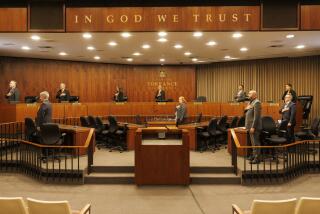Camarillo OKs 1.6% Pay Hike Over Protests
Despite citizen protests that Camarillo city employees are already paid too much, the City Council has tentatively approved increasing workersâ salaries by an average of 1.6%.
The council voted 3 to 2 in favor of the pay raise, but postponed implementing the increase until the state adopts its budget for next year.
The increase would keep Camarillo city salaries roughly 5% above the median for workers in comparable positions in 12 other cities and one county government surveyed by a city-hired consultant.
Until two years ago, Camarillo paid its workers 10% more than their peers, a policy that officials say helped the city attract and keep highly qualified workers.
But in view of the lingering recession, the council voted earlier this year to set the salary scale at 5% above the median, a decrease from the 8% above the median paid last year and the 10% paid in previous years.
On Wednesday, most council members pointed to the decrease to defend themselves against protests that city workers are paid too well.
âWe are recognizing that hard times are here,â said Councilman Stanley J. Daily, who joined Councilman Michael Morgan and Mayor Charlotte Craven in supporting the pay hike.
But Councilmen Ken Gose and David M. Smith--along with about 20 residents who attended the meeting to protest the salary increase--disagreed.
Saying he has never supported Camarilloâs policy of paying higher salaries than neighboring cities, Gose suggested that the council hold the line on any raises for at least a year.
Smith said he could not support even the modest increase proposed because of the recession.
The pay raise will cost Camarillo $68,000. Of the cityâs estimated 103 employees, 22 will receive no increase because they are already paid more than 5% above the median; 17 will get a 0.5% increase; 62 will get raises of 1% and 4%; and 11 will see a 4% to 6% wage hike.
Smith, who works as a financial consultant, said, âThe overwhelming concern I have is . . . I donât believe weâre in normal economic times.â
Tax attorney Gregory Gose, son of Councilman Ken Gose and a former planning commissioner, also asked the council to reject the salary increase to send a message that it is concerned about the poor economy.
âWeâre talking about a difficult issue here,â Gregory Gose told the council. âWeâre talking about the salaries of people who are friends and neighbors.
But raising city salaries is âjust not the right thing to be doing right now,â he said. âTimes are tough and theyâre going to get tougher.â
Instead of raising salaries, the Camarillo Committee of Concerned Taxpayers proposed that the council roll back the 3.8% pay raise granted last year and make even more substantial cuts in salaries for certain positions.
The committee has singled out City Manager J. William Little, calling for his $116,724 salary to be cut to about $104,000.
Little spoke up Wednesday, not to defend himself but in support of other city employees.
He said Camarillo has nearly $4 million in reserves and is in better financial shape than many neighboring cities.
To say the city should reduce wages because other government agencies have done so, he said, is like saying that every business should lay off staff because McDonnell Douglas cut its work force.
âIt just doesnât make sense,â Little said. âI donât think city employees should be sacrificed . . . just to show weâre concerned about the economy. I just donât think thatâs fair.â
And Morgan jumped to the defense of Little, who earns more than the city managers in Thousand Oaks, Simi Valley and Ventura, according to the study commissioned by the city by Ralph Andersen and Associates of Sacramento.
With Littleâs guidance, Morgan said, Camarillo recovered from its 1988 fiasco, when the city lost $25 million in high-risk investments.
After the financial disaster, then-City Manager Thomas Oglesby retired, and the city hired Little.
More to Read
Sign up for Essential California
The most important California stories and recommendations in your inbox every morning.
You may occasionally receive promotional content from the Los Angeles Times.










